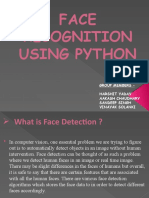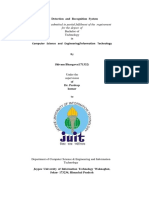Batch2_Face Detection using Python
Uploaded by
ramesh.nBatch2_Face Detection using Python
Uploaded by
ramesh.nABSTRACT :-
Title :- FACE DETECTION BY USING PYTHON
Face detection is a fundamental task in computer vision, involving the identification and
localization of human faces within digital images or video streams. Using Python, face
detection can be efficiently implemented with various libraries, most notably OpenCV,
Dlib, and the deep learning-based framework,MTCNN.OpenCV (Open Source Computer
Vision Library) provides pre-trained classifiers like Haar cascades and LBP (Local
Binary Patterns) cascades. These classifiers are applied to grayscale images to detect
facial features. The process involves scanning the image at different scales and locations
to identify regions that match the classifier's model of a face. While effective and fast,
this traditional method may struggle with detecting faces under different lighting
conditions or at extreme angles.
Dlib, on the other hand, offers a more robust solution through its Histogram of Oriented
Gradients (HOG) detector and deep learning-based methods. The HOG method detects
faces by analyzing the distribution of gradient orientations, making it more accurate than
Haar cascades. Dlib’s deep learning method uses a Convolutional Neural Network (CNN)
trained on a large dataset, achieving high accuracy in detecting faces even in complex
environments.
MTCNN (Multi-task Cascaded Convolutional Networks) is another powerful tool for
face detection, particularly for its ability to handle multi-scale detection and alignment. It
operates through a three-stage process: proposal of candidate windows, refining of these
candidates, and finally, outputting the detected face
withlandmarks(eyes,nose,mouth).Python’s versatility and the availability of these
libraries make it an excellent choice for implementing face detection systems. These
systems are applicable in a wide range of fields, from security and surveillance to
entertainment and social media, offering both real-time accuracy.
You might also like
- An Approach For Face Detection and Face Recognition Using OpenCV and Face Recognition Libraries in PythonNo ratings yetAn Approach For Face Detection and Face Recognition Using OpenCV and Face Recognition Libraries in Python5 pages
- An Approach for Face Detection and Face Recognition Using OpenCV and Face Recognition Libraries in Python (1)No ratings yetAn Approach for Face Detection and Face Recognition Using OpenCV and Face Recognition Libraries in Python (1)5 pages
- Designing Iot Face Recognition Robot: Shreenivas TelkarNo ratings yetDesigning Iot Face Recognition Robot: Shreenivas Telkar5 pages
- Face Detection and Recognition System: Mr. Tilak Pandya, Mr. Praveen Chauhan, Ms. Viplavi PanchalNo ratings yetFace Detection and Recognition System: Mr. Tilak Pandya, Mr. Praveen Chauhan, Ms. Viplavi Panchal8 pages
- Face Recognition System: Abstract-We Present An Approach To The Detection andNo ratings yetFace Recognition System: Abstract-We Present An Approach To The Detection and6 pages
- Face Detection and Recognition Using Opencv and PythonNo ratings yetFace Detection and Recognition Using Opencv and Python3 pages
- Face Detection System With Face RecognitionNo ratings yetFace Detection System With Face Recognition8 pages
- Abstract:: Case Study of Real Time Based Facial Recognition System For Criminal IdentificationNo ratings yetAbstract:: Case Study of Real Time Based Facial Recognition System For Criminal Identification5 pages
- Face Mask Detection Using Python and Deep LearningNo ratings yetFace Mask Detection Using Python and Deep Learning16 pages
- Intelligent Facial Recognition and Analytics System - User Alert Functionality With Personalized Notifications-1No ratings yetIntelligent Facial Recognition and Analytics System - User Alert Functionality With Personalized Notifications-12 pages
- Face Recognition Using Haar Cascade Classifier: Varun Garg Kritika GargNo ratings yetFace Recognition Using Haar Cascade Classifier: Varun Garg Kritika Garg3 pages
- Finding Missing Person Using ML, Ai: Neha Gholape, Ashish Gour, Shivam MouryaNo ratings yetFinding Missing Person Using ML, Ai: Neha Gholape, Ashish Gour, Shivam Mourya4 pages
- Face Recognition Attendance System Using Python (With Code)No ratings yetFace Recognition Attendance System Using Python (With Code)9 pages
- Face Recognition Technique Based Student Attendance Management System (1)No ratings yetFace Recognition Technique Based Student Attendance Management System (1)5 pages
- Divya - Detection of Face Spoofs With Raspberry PiNo ratings yetDivya - Detection of Face Spoofs With Raspberry Pi34 pages
- Introduction To Innovative Projects Face Recognition (Opencv)No ratings yetIntroduction To Innovative Projects Face Recognition (Opencv)20 pages
- Face Detection in Python Using OpenCV YOLO Pandas Numpy and CNN Algorithms_20250324_203905_0000No ratings yetFace Detection in Python Using OpenCV YOLO Pandas Numpy and CNN Algorithms_20250324_203905_000018 pages
- Theoretical and Practical Analysis On CNN, MTCNN and Caps-Net Base Face Recognition and Detection PDFNo ratings yetTheoretical and Practical Analysis On CNN, MTCNN and Caps-Net Base Face Recognition and Detection PDF35 pages


































































